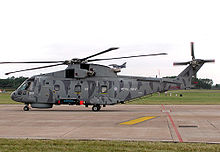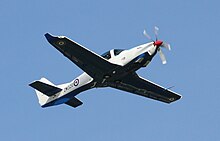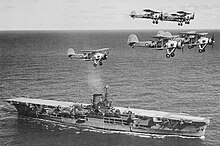Fleet Air Arm
The Fleet Air Arm (short FAA ) as part of the British Royal Navy responsible for the operation of aircraft on board its ships. The Fleet Air Arm operates the Lockheed Martin F-35 in a maritime attack role , the AW159 Wildcat and AW101 Merlin in command and anti-submarine roles, and the BAE Hawk in an aggressor role.
|
Fleet Air Arm |
|
|---|---|

|
|
| Lineup | April 1, 1924 |
| Country |
|
| Type | Flotilla ( Royal Navy ) |
| Strength | 6,200 |
| insignia | |
| Aircraft cockade |
 
|
| Low-visibility roundel semi-transparent cockade |

|
history
The beginnings
In January 1914, the Air Department of the British Admiralty founded the Royal Naval Air Service ( RNAS for short ). When the First World War broke out , the RNAS had control of a greater number of aircraft than the British Army's Royal Flying Corps (RFC) .
The main task of the RNAS was reconnaissance flights over sea and patrol flights along the coast against enemy ships and submarines, as well as defense against enemy air attacks. In April 1918, the RNAS, which at that time had a staff of 67,000 and had 2,949 aircraft, 103 airships and 126 coastal stations, merged with the Royal Flying Corps to form the Royal Air Force .
Fleet Air Arm
On April 1, 1924, the Fleet Air Arm of the Royal Air Force was established. This included all those units of the RAF, which were stationed on aircraft carriers and combat ships. On May 14, 1937, the Fleet Air Arm went back under the command of the Admiralty. When the Second World War broke out , the Fleet Air Arm consisted of 20 squadrons with a total of only 232 aircraft. The equipment inventory still included biplanes like the Fairey Swordfish . In 1945 the strength of the Fleet Air Arm was 59 aircraft carriers , 3,700 aircraft, 72,000 people and 56 air bases, which were distributed all over the world. The aircraft carrier had ousted the battleship as a capital ship in the fleet. Carrier-based aircraft were now self-directed assault weapons.
Post war history
After the war, the FAA faced the difficult task of integrating jets into aircraft carrier operations. The jet planes of that time were much less effective than propeller planes at low speeds, which in turn were unable to fight fast-flying jets. In the late 1940s, the FAA received its first jet aircraft, the Sea Vampire . The Sea Vampire was the first jet that could take off and land on an aircraft carrier. At the same time, the FAA also used powerful propeller planes in addition to the jets. In the Korean War , however, the FAA was clearly inferior to the enemy jet aircraft. A squadron of Hawker Sea Furies managed to shoot down a MiG-15 and damage other enemy aircraft in one attack .
As the jets got bigger, stronger and faster, they needed longer distances to take off and land. The United States Navy therefore simply built larger aircraft carriers. The Royal Navy also built a few large aircraft carriers after the war, but due to notorious budget problems, a more economical, “more natural” solution was sought. This led to the introduction of the Hawker Siddeley Harrier VTOL aircraft, which could be used effectively from vessels of any size. In the 1970s, budget cuts by the British armed forces led to the cancellation of all previous aircraft carriers of the Royal Navy. Nevertheless, it was possible to build a new series of carriers in the format of cruisers, the Invincible -class , and to equip them with Sea Harrier aircraft. Until 2010, the Harrier were the backbone of the Royal Navy's fixed-wing forces.
Helicopters have also become an important part of the Navy Air Force since the 1960s. At first they were used next to the fixed-wing aircraft on the carriers, later they were also used on most of the smaller ships. Today every ship the size of a frigate or larger has at least one helicopter. Westland Wasps and Sea Harrier played an important role in the 1982 Falklands War . In 1991, Westland Lynx were used in the attack on Iraqi patrol boats in the Second Gulf War . Sea Kings provided assistance in fighting insurgents in Sierra Leone .
The Fleet Air Arm has its own museum at the Royal Naval Air Station Yeovilton base in Somerset .
organization
The FAA is in squadrons ( Squadrons organized). They are named with "# NAS", where "#" is a number and NAS stands for "Naval Air Squadron" (Marine Air Squadron). The numbers from the range 700 to 799 are used for training units and numbers from the range 800–899 for squadrons in operational use. During World War II, the 1700s and 1800s number ranges were also used for squadrons in operational use.
The following FAA squadrons are currently active, mainly based on two military airfields , see the main article on the Royal Navy . Some units are in other places for flight training ( RAF Barkston Heath and RAF Shawbury ). (Note: In the English wikipedia there is a list of former bases.)
Flight training
- 700X Naval Air Squadron
- 703 Naval Air Squadron
- 705 Naval Air Squadron
- 727 Naval Air Squadron
- 736 Naval Air Squadron
- 750 Naval Air Squadron
Task Force
- 809 Naval Air Squadron , reactivation scheduled for 2023
- 814 Naval Air Squadron
- 815 Naval Air Squadron
- 820 Naval Air Squadron
- 824 Naval Air Squadron
- 825 Naval Air Squadron
- 845 Naval Air Squadron
- 846 Naval Air Squadron
- 847 Naval Air Squadron (a unit of the Royal Marines )
- 849 Naval Air Squadron
equipment


The FAA operates both fixed-wing aircraft and helicopters. The aircraft are named according to the same system used by the RAF.
The Harrier GR.9 attack aircraft and the Harrier T.12 training aircraft variant, which were used together with the Royal Air Force as the "Joint Force Harrier", were initially decommissioned at the end of 2010 without replacement.
The FAA operates 174 aircraft. These are primarily helicopters with additional F-35 aircraft that are currently being tested.
- Attack helicopter
- 32 AgustaWestland Merlin HM2 , anti- submarine helicopter.
- 28 AgustaWestland AW101Merlin HC.3 / 3A , transport helicopter for the Royal Marines , especially for the 3 Commando Brigade or
- 28 AgustaWestland Wildcat HMA2 multipurpose helicopter
- Training aircraft
- 15 BAE Hawk T1 , target presentation in various training scenarios (airborne early warning systems, flight control of fighter pilots, air combat training)
- 4 Beechcraft Avenger T1 (King Air 350ER) , trainer for the mission specialists on the helicopters.
- Grob 120TP Prefect , basic trainer for pilots.
- Grob Tutor , used for pilot selection.
future plans
The Royal Navy plans to deploy the F-35B Lightning II ( STOVL ) around 2020 from the new Queen Elizabeth-class aircraft carriers , whose water displacement is said to be three times that of the previous carriers.
Notable members of the Fleet Air Arm
- Aircraft Mechanic First Class Henry Allingham - last survivor of the Battle of the Skagerrak
- Lieutenant Commander (A) Eugene Esmonde VC , DSO - died on February 12, 1942 while commanding the 825 Naval Air Squadron with Fairey Swordfish in the attack on the battleships Scharnhorst and Gneisenau at Operation Cerberus
- Lieutenant Laurence Olivier - famous British actor and director, volunteer naval aviator in World War II, rose to the rank of lieutenant.
- Prince Andrew, Duke of York - served in the Falklands War
- Sir George Martin - producer of the Beatles
See also
Web links
- Fleet Air Arm website
- Fleet Air Arm Archives
- RUM RATION - unofficial Royal Navy forum
- Fleet Air Arm Rating Aircrewmans Association
- Fleet Air Arm Association
- Aircraft Handlers Association
literature
- Ray Sturtivant & Theo Ballance: The Squadrons of the Fleet Air Arm , first edition 1994, Air Britain, Kent UK, ISBN 0-85130-223-8 .
Web links
Individual evidence
- ↑ F-35 Lightning | Royal Navy. Retrieved May 6, 2020 .
- ↑ Wildcat | Royal Navy. Retrieved May 6, 2020 .
- ↑ Merlin Mk3 | Royal Navy. Retrieved May 6, 2020 .
- ↑ Merlin Mk 2 | Royal Navy. Retrieved May 6, 2020 .
- ↑ Hawk | Royal Navy. Retrieved May 6, 2020 .
- ^ Fleet Air Arm, Naval Aviation, Royal Navy Air Service History. Retrieved May 6, 2020 .
- ↑ Sea Your History - Interwar: Fleet Air Arm ( Memento from May 5, 2009 in the Internet Archive )
- ↑ 700X Naval Air Squadron | Royal Navy. Retrieved May 6, 2020 .
- ↑ 703 Naval Air Squadron | Royal Navy. Retrieved May 6, 2020 .
- ↑ 705 Naval Air Squadron | Royal Navy. Retrieved May 6, 2020 .
- ↑ 727 Naval Air Squadron | Royal Navy. Retrieved May 6, 2020 .
- ↑ 736 Naval Air Squadron | Royal Navy. Retrieved May 6, 2020 .
- ↑ 750 Naval Air Squadron | Royal Navy. Retrieved May 6, 2020 .
- ↑ 809 Naval Air Squadron | Royal Navy. Retrieved May 6, 2020 .
- ↑ 814 Naval Air Squadron | Royal Navy. Retrieved May 6, 2020 .
- ↑ 815 Naval Air Squadron | Royal Navy. Retrieved May 6, 2020 .
- ↑ 820 Naval Air Squadron | Royal Navy. Retrieved May 6, 2020 .
- ↑ 824 Naval Air Squadron | Royal Navy. Retrieved May 6, 2020 .
- ↑ 825 Naval Air Squadron | Royal Navy. Retrieved May 6, 2020 .
- ↑ 845 Naval Air Squadron | Royal Navy. Retrieved May 6, 2020 .
- ↑ 846 Naval Air Squadron | Royal Navy. Retrieved May 6, 2020 .
- ↑ 847 Naval Air Squadron | Royal Navy. Retrieved May 6, 2020 .
- ↑ 849 Naval Air Squadron | Royal Navy. Retrieved May 6, 2020 .
- ↑ Military Aircraft: Written question - 225369. Retrieved May 6, 2020 (English).
- ↑ Merlin Mk 2 | Royal Navy. Retrieved May 6, 2020 .
- ↑ Merlin Mk3 | Royal Navy. Retrieved May 6, 2020 .
- ↑ Wildcat | Royal Navy. Retrieved May 6, 2020 .
- ↑ 750 Naval Air Squadron | Royal Navy. Retrieved May 6, 2020 .
- ^ Royal Air Force. Retrieved May 6, 2020 (UK English).
- ↑ 727 Naval Air Squadron | Royal Navy. Retrieved May 6, 2020 .




